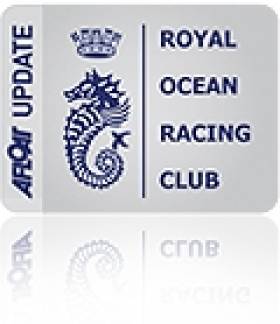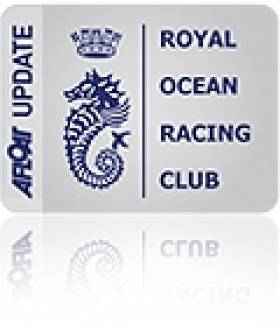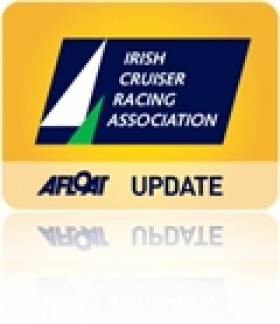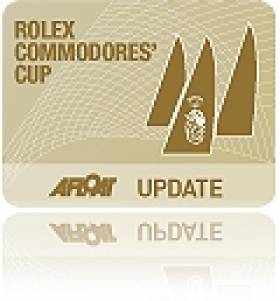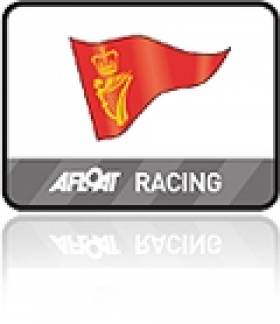Displaying items by tag: Anthony O'Leary
Ireland Tipped As Commodore's Cup Favourites
#commodorescup – Having won the Commodores' Cup in 2010, Ireland was unable to mount a campaign to defend its title in 2012, but this year they are returning to Cowes for the RORC's biennial regatta for amateur national three boat teams, over 19th-26th July, with one of the strongest line-ups taking part writes James Boyd.
In recent years, while France and Britain have entered large numbers of boats into the Brewin Dolphin Commodores' Cup, Ireland's efforts have been notable for achieving top results but with a smaller but more powerful line-up. In 2006 they fielded three teams with Ireland Green coming home second to the French while, in 2008, Ireland was favourite going into the regatta but its two teams ended up second and third to GBR Red. Finally in 2010 it was third time lucky. The single Irish team dominated the regatta, finishing well ahead of Hong Kong and France.
This year's line-up continues this theme, with former Vice Commodore of the RORC Anthony O'Leary resuming his duties as Irish team leader and skipper of his Ker 39, Antix. The Irish 'big boat' is American Marc Glimcher's turbo charged Ker 40, Catapult, while making up the trio is a former IRC Nationals winner, Peter Rutter's Grand Soleil 43, Quokka 8, chartered for the occasion by Niall Dowling and present RORC Vice Commodore Michael Boyd.
According O'Leary, they started work on the campaign immediately after the 2012 Brewin Dolphin Commodores' Cup. His Olympic Star sailor son Peter was friends with American Olympic sailor Geoff Ewenson who serves as tactician on Catapult and between them they managed to persuade owner Marc Glimcher to bring the boat across from the USA for the season. Catapult has been in the UK since April and competed in the IRC Nationals, finishing third in IRC One behind Antix and Michael Bartholomew's GP42 Tokoloshe II.
Compared to the other Ker 40s, Catapult is lighter but with a deeper draft to retain her stability. As a result she has a higher IRC TCC of 1.210 compared to standard Ker 40s, such as the British team's Cutting Edge (1.195) and Hooligan VII (1.192). Given her higher performance, one imagines Catapult will benefit from being able to nose ahead of the other Ker 40s and into clear air.
To comply with the nationality requirements of the Brewin Dolphin Commodores' Cup, more than half of Catapult's crew will be Irish, with Ewenson and Peter O'Leary being the boat's two permitted 'pro' sailors, O'Leary still being classified ISAF Group 3 following his Star campaign for London 2012.
Antix herself has returned to her old form, winning this year's IRC National Championship. According to her owner, part of the reason for this is due to them returning the boat to her successful 2010 configuration. "After 2010 we lightened the boat overall and the bulb, but it didn't turn out to be that successful. Fortunately we hadn't disposed of the original bulb and we put it back, which was an easy change."
This time the O'Leary trio of sons is evenly distributed across the Irish fleet with Robert on Antix, Peter on Catapult and Nicolas on Quokka 8. As O'Leary puts it: "I think four of us on the same boat could lead to some family disputes and what have you, so it was best to spread the load around the place!"
The pros on Antix and Quokka 8 are North Sails' Dave Lenz and Maurice 'Prof' O'Connell respectively, both of whom competed in 2010 (O'Connell then sailing on Roxy) while on Quokka 8 Michael Boyd will be navigating and Niall Dowling helming. Roughly half of the Antix crew competed in O'Leary 2010 winning crew.
Interestingly while Anthony O'Leary is an old Brewin Dolphin Commodores' Cup hand, both the Catapult and Quokka crews are first timers. As O'Leary puts it: "The Americans haven't done it before, so they are fascinated with the team concept and the general layout of the regatta."
Meanwhile Quokka was late returning from her regatta program in the Caribbean and O'Leary was impressed that to fill the gap, Niall Dowling and Michael Boyd chartered other boats to help get their crew race ready. "That has taken a lot of effort and focus," he says.
Generally O'Leary feels confident of his team's prospects against the sizable GBR competition, which they regularly sail against. However the French are an unknown quantity, with the exception of Antix's sistership, the Gouy family's Inis Mor, which he says is particularly strong offshore. "If we arrive with our A-game we'll be confident of a decent result."
As to why O'Leary is spearheading another campaign for the Brewin Dolphin Commodores' Cup, he explains that the attraction is: "An event of that duration with so many races, and such a variety of races, without a discard - it is full on. The intensity of it is great, it is just what you want to sail. It is the highlight of our programme every two years."
Anthony O'Leary Is 'Sailor of The Month' For June
#sailorofthemonth – Top Cork skipper Anthony O'Leary's success in achieving the overall title in the British Open IRC Championship has made him the runaway winner of Afloat.ie's "Sailor of the Month" title for June.
O'Leary's dedication in campaigning his Ker 39 Antix is a by-word for enthusiasm in Irish and international sailing. Allied as it is to his long-proven skill in getting that vital extra ounce of performance from boat and crew, the result is a prodigious record of success.
In the finest Royal Cork traditions, O'Leary puts even more into his beloved sport than he takes out of it. He has served as an Admiral of the Royal Cork Yacht Club and a Flag Officer of the Royal Ocean Racing Club, and currently he is both Captain of the 2014 Irish Commodore's Cup team, and a leading figure in the organisation of Volvo Cork Week 2014 which gets under way this weekend.
The fleet taking part will include a significant number of leading international racers, a tribute to the high regard in which Cork sailors of the calibre of Anthony O'Leary are held.
#rorc – Royal Cork's Anthony O'Leary's Ker 39, Antix has won the prestigious British IRC Championship title on the Solent this afternoon. Despitere being one of the smallest boats in Class one the Munster crew continued their impressive display, winning the first two races of the day to secure the IRC One title, and third place in the last race of the regatta was just enough to secure the overall win. Antix was crowned RORC IRC National Champion to the delight of the Irish crew.
It's an important result scored at an important time only weeks ahead of the Commodore's Cup where O'Leay will captain a three boat Irish team against some stiff international competition. Tonight, O'Leary's result was being toasted at his Royal Cork Yacht Club but the international result was also saluted in Dublin where the Irish IRC and ICRA championships were concluding at the Royal Irish Yacht Club.
The most sensational finish in the 13-year history of the RORC IRC National Championship played out in the central Solent this afternoon. In the tightly packed combat zone, the prize of overall national champion was decided in the ninth and final race of the series. Three yachts swapped the overall lead during the last three races. Keeping in clear air and playing the shifts were the big factors towards a top performance but maintaining concentration, in an adrenalin packed final day, was just all important.
"Antix has been coming here for years, we have won class here before but this is the first time we have won the event overall - it is just tremendous," smiled Anthony O'Leary. "Dave Lenz did a phenomenal job on tactics and the rest of the crew have been together for many years and that understanding kept our manoeuvres clean. The combination of smart strategy and good boat handling was the key. As one of the smallest boats in our class, we knew that we would be dictated to at the starts, and on several occasions, we did have to tack away for clear air. However, our heads never went down, and many-a-time we were in good shape by the top mark. This is a confidence boost for the Commodores' Cup but our feet will be firmly on the ground and we will continue to prepare for next month's big event."
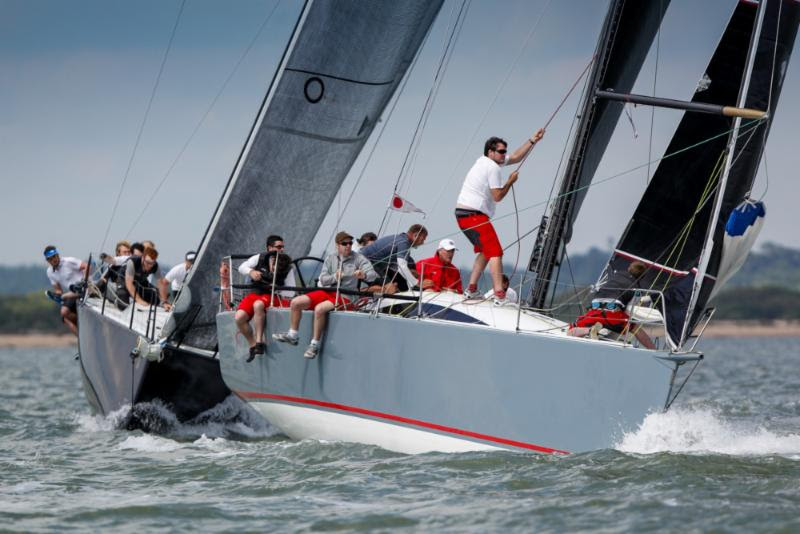
Cork's Antix in the lead on the Solent this aftenoon. Photo: Paul Wyeth
Mike Bartholomew's South African GP42, Tokoloshe II, was second in class and Marc Glimcher's American Ker 40, Catapult, finished the regatta in style winning the last race to place third.
IRC Two
Going into the last race, Jim Macgregor's British Elan 410, Premier Flair, needed to win to secure the overall IRC National title by just half a point. However, the team from Poole YC could only manage fourth. Premier Flair was class champion and second overall, winning the Jackdaw Trophy.
IRC Two produced a highly competitive fleet with seven yachts all scoring podium finishes and virtually every race was decided by seconds, so close in fact that Premier Flair and Adam Gosling's Corby 36, Yes!, scored a dead heat for Race 7. Kevin Miller's Scottish First 40, Zephyr, held on to second place for IRC Two. Yes! damaged their backstay in Race 8, ending any remote chance of a class win, but first in the last race of the regatta secured Yes! third in class.
"To be honest, if Yes! had not had their problems, we would have been beaten," admitted Jim. "The competition in our class this year was as good as I can remember and we are delighted to be taking the Jackdaw Trophy back to Poole YC. We had no idea we were in the running for the overall win, that comes as a bit of a shock for a Corinthian team. We were just taking it one race at a time, and thoroughly enjoyed every one of them."
IRC Three
David Franks' British JPK 10.10, Strait Dealer, won all three races today to secure the class. Scoring six bullets during the regatta, Strait Dealer was an outstanding performer. However, the smaller class size put the team from Cowes out of the running for the overall win. Last year's IRC Three champion, James Chalmers' British J/35, Bengal Magic, was second and Willem Schopman's Dutch Bashford Howison 36, Intention, was third.
"This is our second class win at the championship but every year it gets harder and harder," commented David. "The RORC have put on another excellent event, especially in difficult conditions, and that should not be underestimated. Each day was very different and all of the Solent came into play, at one stage or another, which kept us all thinking, as well as the race officer."
IRC Four
Peter Morton's Half Tonner, Swuzzlebubble, was the winner of the class but struggled today in the fresher breeze. Giovanni Belgrano's Whooper won the first race of the day and secured second overall. Sadly, Ian Southworth's Hamble based Quarter Tonner, Whiskers, was unable to race after yesterday's rig damage, but after being awarded redress, ended the regatta third in class. Michael Kershaw's Half Tonner, Chimp, won Race 8 and last year's class winner, Nick and Adam's J/97, Indulgence, finished the regatta on a high, winning the last race.
"This is the first big regatta for the boat since it was re-launched and we have learnt a lot about how to sail her," commented Peter Morton, skipper of Swuzzlebubble. "We were joined this weekend by Tom Schnackenberg, who has won the America's Cup three times and knows a hell of a lot about these boats. I bought Swuzzlebubble for one euro, I have spent a lot of money on her, but about only half the cost of some of the boats racing this weekend. She definitely goes well in the light but against the displacement boats, we suffered in more breeze."
Racing with the Royal Ocean Racing Club continues with the Morgan Cup Race on Friday 27th June, followed by the Round Ireland Race, Saturday 28th June.
Click HERE for full provisional results for the RORC IRC National Championship.
#antix – Irish Commodore Cuppers are in the frame on the Solent as the RORC British IRC National Championship goes into its third and final day with fickle conditions but stronger than those encountered at the Irish IRC Championships being sailed at the same time on Dublin Bay.
Royal Cork's Anthony O'Leary's Ker 39, Antix, is the new leader after the second day of racing.
The Eastern Solent provided a fascinating combat zone as Mike Bartholomew's South African GP42, Tokoloshe, slipped to second place, four points off the lead. Marc Glimcher's American Ker 40, Catapult, had an excellent day on the water, climbing to third place by virtue of two bullets and a second, beaten by Antix by just 17 seconds. There were podium finishes today for Harmen de Graaf's Dutch Ker 40, Baraka GP, and Stewart Whitehead's Farr 45, Rebel.
A fickle northerly breeze at the start provided shifty conditions before clocking east and building to a solid 15 knots of pressure. During the final race a massive rain squall brought a short sharp intensity to the final race with over 20 knots of wind and driving rain, testing the endurance of the teams. The second day of the championship was full of incident and intense boat-on-boat action. The teams that handled their yachts well, in close quarters and rapidly changing conditions, were the outstanding performers of the day.
IRC One
Catapult's Boat Captain, Geoff Ewenson from Annapolis USA, spoke about the tactics for the second race of the day. "The tide was building, across the course from east to west and getting the wrong side of that was not a good option. Even though there was more breeze down tide, we stayed high and that kept us in good shape. The same was true for the tight reach past Lee on Solent. The northerly breeze was being affected by breeze from the east and a significant wind hole was developing. Once again we stayed high to avoid being headed in light air. With clear air we were able to sail faster than the competition and extend our lead."
IRC Two
The new leader, after six highly competitive races, is Jim Macgregor's British Elan 410, Premier Flair, pushing yesterday's leader, Kevin Miller's Scottish First 40, Zephyr into second place, just three points off the lead. Adam Gosling's Corby 36, Yes!, had a highly successful day, winning two of today's races to move up to third. There were podium finishes for Corby 37, Aurora, sailed by Roderick Stuart, Peter Morton's JND 35, Salvo, and Paul McNamara &Tony Lowes's First 40.7, Incognito. Richard Patrick's First 40, Dusty P, won the last race of the day by just two seconds.
Jim Macgregor, owner of Premier Flair, has been joined this weekend by his daughter Kate, who represented Great Britain at the London Olympic Games, and members of the Poole Yacht Club Youth programme. "It is always great to sail with my family and Kate was working the bow yesterday. We have a number of youngsters on the boat, some only 16 years old, which brings the average age down! After a long day yesterday, today was always going to be a test of endurance and it ended with four of us going around the leeward mark together, trying to drop spinnakers in a rain squall packing 26 knots, so it was quite a finale. We are delighted to be in the lead but tomorrow should be an interesting day."
IRC Three
David Franks British JPK 10.10, Strait Dealer, retained the class lead with three podium finishes today including a win in Race Six, but the best performer today was James Chalmers' J/35, Bengal Magic, which won the first race of the day and followed up the victory with two second places. Willem Shopman's Bashford 36, Intention, scored their first win of the championship, taking Race Five by just 11 seconds and promoting the Dutch team to third place. Strait Dealer has a net points score of just nine after six races, the lowest of any yacht racing at the regatta.
Graham Sunderland, a Solent tide expert, is navigator for Strait Dealer. "I have never seen such a mixture of mud and clear water on the east end of the plateau before and it produced highly unusual effects, with that wind direction and tidal flow. Race Officer Stuart Childerley and his team did a sensational job - full marks for the courses today. The Strait Dealer team were also great today; with excellent boat handling skills, it makes strategy so much easier."
IRC Four
Ian Southworth's Quarter Tonner, Whiskers, had an excellent start to the day, nailing the pin end of the line to win Race Four by a big margin. However a collision in Race Five damaged the rig to such an extent that Whiskers can no longer race. Peter Morton's Half Tonner, Swuzzlebubble, retains the class lead. Giovanni Belgrano's Whooper revelled in the heavy conditions in Race Six to score her first win of the championship and are currently just three points off the lead. Whiskers is lying in third place, however a request for redress may alter the situation.
Racing continues this morning for the final day of the RORC IRC National Championship with three more races scheduled before the overall and class champions will be decided.
Results here
O'Leary to Captain Potent Irish Commodore's Cup Team
#commdorescup – Although Ireland will be setting sail for Cowes as a potent Commodore's Cup force this July it will only be a single team as a second 'corinthian' team could not be mustered. At the Spring meeting of the ICRA executive, Commodore's Cup team manager Barry Rose made a detailed report on preparations. The meeting heard the team will sail without the support of sponsorship, in spite of major effort by the Irish Cruiser Racing Association (ICRA) to secure a team sponsor none had been found.
Anthony O'Leary has been confirmed as team captain, a position he also held in the 2010 Commodores' Cup winning Irish team.
As has been widely reported the three boat Irish team consists of Catapult, a US based Ker 40 which had been shipped to the Solent and was due to be enter the water to start her training programme on the 1st May.
Quokka, a Grand Soleil 43, had been chartered by Royal Irish sailors Michael Boyd and Niall Dowling. O'Leary's Antix, a Ker 39, completed the line-up.
The services of meteorologist Mike Broughton had again been secured on an exclusive basis to provide local tactical and Solent tidal support to the team.
#irishsailing – After five years of economic contraction, there are signs of recovery, and the 2014 Irish sailing season has also got off to a flying start. W M Nixon looks at various signs of new energy and initiatives, and sees how they might be affecting stories which have been run on this blog and in the Afloat.ie website during the past year. But he concedes that further cost reductions will be necessary for the good of the sport.
A year ago, any talk of green shoots in Ireland was almost entirely metaphorical. And it was in the economic sphere, though even there they were still few and far between, with many soon stunted. But out in the farmers' fields themselves, out where the grass should have been growing, there was scarcely a sign of life as we were still trapped in the coldest and most miserable Spring in living memory, and all forms of growth and recovery were blighted by it.
Sailing and boating, of all sports, are the most affected by Ireland's climatic conditions. Not only is the mood among participants strongly influenced by weather which sometimes can get anyone down, but without reasonable breezes, sailing events are seriously impaired. "We got a result!" may well be the PRO's final desperate claim after pulling some sort of a points table and leaderboard out of a series bedevilled either by too much or too little wind. But it's so much better to have a series bathed in sunshine and blessed by fine breezes, with enough races sailed for the crews to go home tired but happy without needing recourse to any of those weasel words which show you're only trying to justify a weekend of frustration.
Things could not be more different this year. The Spring of 2014 has been perfection, boats are going afloat on time and in reasonable weather conditions, and the first little crop of events and results are very encouraging indeed - so encouraging, in fact, that "little crop" doesn't do them justice.
That said, two of the nearer events which gave special cause for Irish celebration did not have perfect weather throughout. The Youth Sailing Nationals at Howth may have ended on a high with a great breeze in an early taste of summer sunshine, but one day out of the four was lost to bad weather. But the sting of that was lessened by the decision for "no racing all day" being taken at 1100hrs, which allows other leisure options to kick in.
The IRC Easter Championship in the Solent concluded through Easter Monday literally with "Darkness at Noon" – the heavy clouds and torrential rain on an almost windless day saw the final races being sailed with nav lights on. But there had been excellent racing on earlier days, and a very excellent result with Anthony O'Leary's Ker 39 Antix from Cork the clear supreme champion.
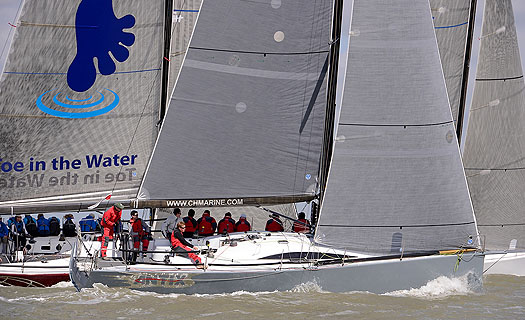
Doing the business. Anthony O'Leary's Ker 39 Antix settling into the groove on the way to the top place in the Easter IRC Championship. Photo: Rick Tomlinson
That in turn augured well for Ireland's Commodore's Cup chances, which then received a further boost last weekend when the crew of another Irish team wannabe, Quokka with Michael Boyd and Niall Dowling, had a winning weekend in the Warsash series with their temporary mount Tarka in anticipation of Quokka's return from the Caribbean at the end of May.

The Colours Match team racing between UCD and Trinity served up top sport in the Liffey, with Trinity winning. Photo: W M Nixon
Meanwhile the universities racing has been brought to life, for although UCD had a convincing win in the racing with the SailFleet J/80s to become the Irish team for the Student Yachting Worlds in France in the Autumn, before April was out the Colours Match in the Liffey under the burgee of the Royal Alfed YC, team-raced in Fireflies, saw Trinity take the honours in convincing style.
But if we're looking for something which really did set things freshly alight, it was out in Hyeres where the ISAF Championship saw the northern duo of Ryan Seaton & Matt McGovern take silver in the 49er, almost immediately moving them up the global rankings from 33 to 11, a quantum leap and no mistake.
The potential for serious success by these two has been fairly obvious for some time, but anyone who sails boats will know only too well how many factors have to come into alignment to get you up among the magic metals at the end of the day.

Stars of the silver sea – the Seaton/McGovern team took a silver medal for Ireland at Hyeres.
That their new global status was almost immediately acknowledged by this rankings improvement will in turn add heft to everything they do and say. Thus when, some time ago, the Ryan/Seaton equipe suggested that the 2016 Olympics sailing waters in Brazil are so off the standard as to be a health hazard, it attracted polite attention. But now that they're Number 11, and still counting down, much more notice is taken. And the fact that the Vice President of the International Olympic Committee has suggested, with something approaching despair, that the facilities in Brazil just aren't going to be ready for 2016 at any standard, all gives added legs to the statement from Ireland's 49er crew.
This in turn makes us wonder where world sailing might go in 2016 if the Brazilian setup is still Work in Progress. With tongue only slightly in cheek, we suggest they need look no further than West Cork, where Baltimore Sailing Club has been expanding its facilities to meet increased demand as a club which last year introduced something like 700 people to sailing. That BSC and current Mitsubishi Motors "Club of the Year" Kinsale YC further east along the West Cork coast have both been putting in premises up-grade during the past year, while other clubs have been having it tough, and just about hanging in there in some cases, surely gives pause for thought.
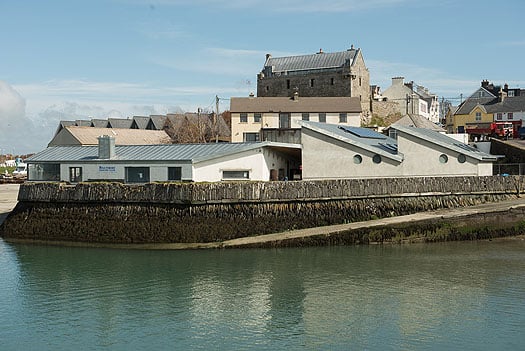
Olympic venue? The extended and up-graded Baltimore Sailing Club is ready and raring to go.
The economic shakeout of the past five years has caused a massive write-down in the value of almost all property and other assets. And in the case of yacht and sailing clubs, there has been a detailed examination of the continuing validity, or otherwise, of established yacht clubs and their traditional business model of quite high subscriptions under-writing other facilities which in turn combine to provide the complete package of an orthodox yacht club.
Inevitably, most clubs are run by officers and committee members who have been involved with the club for many years. Thus, like people who have been running a quality hotel for decades, they may have an inflated notion of what their organisation and its premises are actually worth. Admittedly there's only limited usefulness in comparing a yacht club with a hotel, but lessons can surely be learned. The fact is that hotels today are worth maybe only a third or even less of what they were reckoned to be worth six years ago. And equally, while yachts clubs certainly have a unique package to offer, is it unusual enough and special enough to charge high subscriptions when there are alternative facilities and services available?
The dilemma arises to some extent in all sailing centres. Last week we were discussing the story of the development of Howth YC. Today it is in the seemingly happy situation of having its own marina, thus it theoretically can offer an attractive all-in-one package to any potential member. But the very fact that Howth YC has done so much to help make Howth a colourful and vibrant sailing/fishing port is partly to its own disadvantage. The place has developed as a remarkable focus for top seafood restaurants. This means that the extensive club catering facilities – expected by traditional members - are constantly battling for business with a whole slew of award-winning eateries and characterful pubs nearby.
The problem is more acute in Dun Laoghaire in that the only club within the marina area is the Royal Irish YC. Thus while people may have been loyal members of the National, the Royal St George and the Dun Laoghaire Motor Yacht Club, they find that after going out in the boat, it's very easy to round out the evening aboard in the marina, chatting among themselves or with other crews on boats nearby, and then head straight for home without making their number in their home clubs at all.
This situation is less in evidence at weekends and during special events. But nevertheless it was causing such a lessening in mid-week club vitality that various steps have been taken, and the Royal St George's move to take over berths in a block booking in the outer marina, and service them by a frequent ferry direct from the clubhouse, is a visionary step.
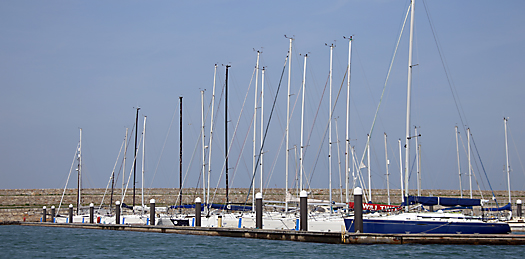
The Royal St George YC has introduced a direct ferry service from the clubhouse to its group of berths in the outer marina in Dun Laoghaire. Photo: David O'Brien
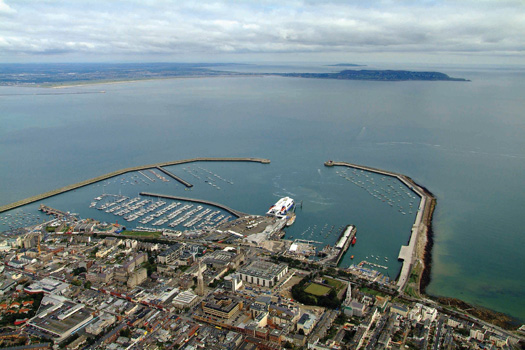
To overcome a lack of direct access to the Dun Laoghaire Marina, the Royal St George YC is running a ferry service from its clubhouse (to right of Stena Ferry, foreground) to the berths in the Outer Marina (upper left) Photo Kevin Dwyer/courtesy ICC.
Nevertheless, in all club administrations there are those who are of the opinion that, whatever the Honorary Treasurers may believe, there has to be a radical re-think of the primary subscription levels. In essence, they're suggesting that the book value of the club has to be written down such that subscriptions are halved. Personally, I haven't much of a notion of how to read a balance sheet, but the dogs in the street know that in the hospitality industry – which, in the broadest sense, is the area in which yacht and sailing clubs operate – values have been savagely slashed, and while charges may still seem high, at least the places are surviving as going concerns.
With continuing reduction in expenses across the board, one area in which there seems to be much work afoot is in the Irish Sailing Association, which in latter days had begun to seem like some hidden corner of the civil service, existing more for the benefit of staff than for the provision of services for sailors. It's amazing to learn that the ISA has sixteen fulltime staff, and a basic annual wages bill of something like €600,000. When you add in the expected benefits, it musty come in total to a very tidy yearly sum.
What on earth do they all do? While you'll invariably find the ISA logo in prominence at some top events, it has to be said that you're entirely unaware of the organisation's existence in any form at more everyday happenings, and it doesn't seem to be because they believe in doing good work by stealth. But with special study groups resulting from the major changes introduced in the ISA setup at the AGM in March, we can only hope that in time the Association will reflect the cost-cutting which has had to be introduced in the clubs, which provide the main part of the ISA's income.
While the administrative structures are rightfully being pared back in many areas of our sport, the coastal infrastructure, on which all forms of seagoing ultimately depend, continues to need maintenance and development. In this area, one very promising green shoot is the news that there are signs of movement in Dunmore East. A dredging programme is getting under way, and just this Tuesday, Minister for Marine Simon Coveney TD convened a meeting in the port to inaugurate a community approach to harbour development which, it is hoped, will help to invigorate the many places around Waterford Estuary, for which Dunmore East has the potential to be the true gateway harbour.

Dunmore East – can it fulfil its potential as the gateway leisure port for the Waterford Estuary? Photo Kevin Dwyer, courtesy ICC
In a more extreme marine environment, it has been confirmed that €6 million will be spent on improving the pier at Doolin in northwest Clare, the nearest mainland quay to the Aran Islands, which also caters for the tour boats cruising along the Cliffs of Moher. While the locals seem well pleased, I wouldn't get too excited about it. This is one very rugged part of the coast, and when you remember that it took €31 million to extend the pier at Kilronan in Inismor, the main Aran island, and another €14 million to build the little harbour at the north end of Inis Meain, the middle Aran island, then we can only hope that €6 million is going to achieve something more than a few boulders being shifted about in the roaring ocean at Doolin.

The pier at Doolin is decidedly minimalist, but it provides the shortest sea passage to the Aran Islands. Photo: W M Nixon
But then, in the west all things are possible, and along the ocean seaboard we're told that four thousand signs are being erected to guide people along the Wild Atlantic Way, the new tourism initiative using many smaller coastal roads. Quite so. Frankly, with signage at this level, it will be the Tame Atlantic Way by the time half of them are in place. I have to admit to being a complete curmudgeon in this. In many years of transitting Ireland's west coast by sea and land, one of our favourite areas while driving along the west coast has long been the coast south of Kilkee down to Loop Head, where the cliffs comfortably rival anything the vulgar Cliffs of Moher have to offer, and it is magnificently uncrowded. But not any more, if the Wild Atlantic Way movement has its way.
While I appreciate that visitor numbers have to be kept up and increased whenever and however, it has to be done in a way which appreciates that's what brings people to Ireland (rather than just to Dublin, which is a special case) is an unspoilt landscape. So, four thousand signs just for the one Atlantic Way? Ogden Nash had something to say about this:
"I think that I shall never see,
A billboard lovely as a tree.
But then, until the billboards fall,
I'll never see a tree at all".
Be that as it may, the final sign that suggests things are on the move again is a notice I spotted recently posted at a nearby club, though language pedants might wonder how a notice which manages to mangle so utterly the plural of "dinghy", even to adding a completely superfluous greengrocer's apostrophe, could be seen as encouraging in any way whatsoever.
Well, once you've overcome your opinions about the errors, the underlying message must be good news. More youngsters are evidently coming to sailing this year. And as for the spelling mistake, even that's an improvement. A year ago, the same notice board opened by referring to something called "a dingy", but this time round we have to get to the second line before finding that. And it all comes right for dinghies in the end.
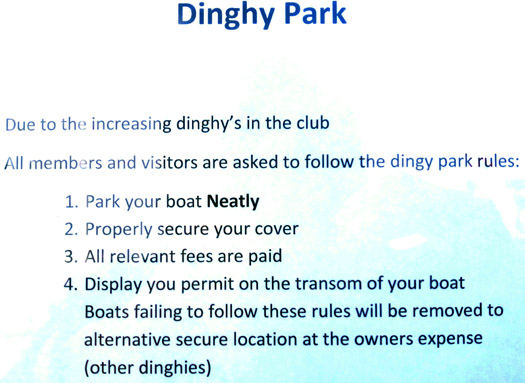
Sign of the times? Whatever about the spelling, this current notice at an Irish sailing club has an underlying message of good news. Photo: W M Nixon
Irish Commodore's Cup Team Announcement Imminent
#commodorescup – An announcement of the three–boat Irish team to contest the Commodore's Cup this July is imminent, according to Afloat.ie sources this morning.
Since last October's news that Ireland is to enter the Cup there has been increased speculation about team composition. Cork Olympic helmsman Peter O'Leary's participation in last month's Key West regatta on the New York based Ker 40 Catapult was seen as the start of the campaign build up. In local Key west interviews both O'Leary and boat owner Mark Glimcher more than hint that the Ker 39 is to join his father Anthony's Ker 39 Antix on the 2014 team leaving Ireland just looking for one more boat to win back a Cup it first won in 2010.
In the Irish Times on January 3, David O'Brien wrote that the third boat is likely to be a Solent based Grand Soleil yacht. One unconfirmed source this morning names this boat as Quokka under former RORC skipper Peter Rutter, a yacht that is currently being campaigned in RORC's Caribbean 600 series.
Quokka, a Grand Soleil 43, is one of the most successful race yachts in the UK. In 2011 she won the IRC Nationals outright. She also finished in the top 10 overall in the Fastnet 2011, won two RORC offshore races and represented Great Britain in the 2009 Commodores Cup.
Team officials from the Irish Cruiser Racing Association (ICRA) have remained tight-lipped on the matter however. "It's still a fluid situation but we're working really hard to make this happen," Barry Rose said in early January but hoped to make an annoucement within the month.
Anthony O'Leary, is expected to lead the Irish team on former winner Antix and following a pre-Christmas meeting of ICRA in Portlaoise, the Grand Soleil was identified as the boat to fill Ireland's third boat slot.
More on this story as we have it.
J109s to Settle National Title at Cork Week 2014
#corkweek – Since 1978, sailors from Ireland and all over the world have enjoyed Cork Week writes Louay Habib. One of Ireland's top regattas has evolved over the years, taking into consideration the changes within the sport but the sailing grounds in and around Cork Harbour have stayed the same. Cork Week offers a variety of courses from Atlantic wind and waves to the tricky tidal confines of Cork Harbour and the legendary 'craic' ashore, hosted by the Royal Cork Yacht Club, significantly adds to the fun.
J Boats
Once again, the J/109 Irish National Championship will be held at Cork Week. A fleet of 20 yachts from Ireland, UK and overseas is expected, confirmed J Boats, Paul Heys. "J Boats has just completed an excellent London Boat Show and we can definitely see a resurgence in demand for J Boats right across the range. The J/109 Irish National Championship has always been a very popular event and we expect a good turn out for Cork Week. The J/70 design is going from strength to strength, with over 600 boats sold in America and Europe. In November, Maurice 'Prof' O'Connell was appointed J Boat dealer for Ireland and we are already seeing demand for the new Sportsboat in Ireland, we expect to see a number of J/70s competing at Cork Week.
High Performance
South African, Mike Bartholomew's Mills 40, Tokoloshe was runner up to Piet Vroon's Dutch Ker 46, Tonnerre de Breskens in 2012 and hopes to return to Cork Week with his new GP42, Tokoloshe.
"The new Tokoloshe needs quite a few modification to get it competitive for IRC and we are working on that now." confirmed Mike Bartholomew. "We hope to come to Cork Week and I am really excited about the prospect, as the competition, the courses and the conditions will, as always, produce excellent racing."
Capable of surfing at over 20 knots, the all carbon flyer will revel in the Cork Week courses on the Atlantic Approaches and Tokoloshe may not be alone. Hamble UK based, High Performance Charter, has similar yachts available to charter for Cork Week.
"Cork Week provides well run races in perfect conditions for fast light displacement race boats. High Performance Charter has a range of yachts available including GP42, Ker 40 and Mills 43." confirmed Bryan Davies. "These yachts will be in top condition for racing and the package includes delivery from Hamble to Cork and back. Basically a team can fly in to Cork have a real blast and fly home again."
Falmouth Boys
Tim Cunliffe's Cornish Half Tonner, Insatiable will be returning to Cork Week after coming runner up in IRC Three last time out. Tim explains why the crew from Falmouth will be coming back, proudly flying the Royal Cornwall YC burgee.
"First and foremost, in 2012 we had a successful Cork Week after arriving with no expectations, so I guess it is rather dangerous to be returning! We had great racing with the RCYC Admiral's team, Bad Company, and we would love another battle with them. We really enjoyed the Irish hospitality and Cork Week delivers the best IRC racing anywhere.
I know that there will be a Cornish contingent coming to race this year. There is an affinity between Cornwall and Ireland given the celtic roots, but also because the scenery is very similar in many ways, there has always a good number of boats from Falmouth that have come to Cork over the years."
1720 Sportsboat
A sizeable fleet of 1720 Sportsboats is expected for Cork Week from Dublin and County Cork based. Sailors from overseas will be joining Irish crews and chartering bareboats boats for their own teams. Jamie McWilliam grew up in Cork but has settled in Hong Kong. This summer McWilliam will be returning to race in the 1720 Class
"For the last few years, the 1720 Class has been having a revival in Ireland and I have been keeping up to date with mates, who tell me the racing is awesome. There is little you can do to optimise the boat, so it is really good one design racing and whilst the size of the fleet has been increasing, so has the strength in depth. For Cork Week, the 1720 Class will have some really great sailors competing and the spirit on and off the water will be superb. 20 years ago, courtesy of Tom Roche and the legendary Noddy, we had the best Cork Week ever and we are looking to wallow in nostalgia in 2014 - but with children this time!"
Cork Week Race Chairman, Anthony O'Leary has confirmed that he will be racing Ker 39, Antix with a very strong Irish team.
"It is very encouraging to see that we will have some excellent yachts and top class sailors coming to enjoy Cork Week but the event has always been about a variety of sailors and yachts, everybody will be made very welcome. The Royal Cork Yacht Club will open its doors to all competitors. As in recent years, Cork Week will serve up a variety of courses both inside and outside the harbour and besides outstanding racing, Cork Week will have a great atmosphere ashore."
The entry fee for Cork Week 2014 will also be reduced by 30%, compared to 2012 and the reduction in racing days and other measures will effectively reduce the overall cost of attending Cork Week by at least 20%.
Entry for Cork Week 2014 can be made via the official website or by contacting the Regatta Office: 00 353 (0)21 4831179
Royal Cork Consistency Puts O'Leary Second at New York Invitational
#nyyc – The Royal Cork Yacht Club, skippered by Anthony O'Leary have yet to score a better result than fifth at New York's Yacht Club's (NYYC) Invitational Cup but their consistency has propelled the Irish team into second place. Anthony is sailing with two of his sons, Nicholas and Robert.
It was a long hard day on the water for the 20 Yacht Clubs competing for the Cup. The start was delayed by several hours waiting for the breeze to fill but when it came, three spectacular races were completed with some of the best racing imaginable. The 200 competing didn't reach the dock until after 5 p.m. and the NYYC apres sailing hospitality was very much appreciated.
During the day, the wind speed ranged from just 5 knots to a feisty 18 knots and with bright sunshine bathing the racing area, between Gould Island and Prudence Island, the second day of racing at the NYYC Invitational Cup was a joy to behold. Mark roundings were not for the faint hearted, as a multitude of boats came barrelling in, often overlapped at virtually every corner.
Race 3 of the series belonged to the Australian team from the Prince Alfred Yacht Club, consolidating their 1-5 scoreline on the first day and putting pressure on the overnight leader, Larchmont (N.Y.) YC. However, Prince Alfred Yacht Club scorecard faltered in the last two races of the day, as costly errors pushed the team down to sixth overall.
Meanwhile Larchmont YC continued the charge taking another second place to consolidate their position at the top of the leader board. However in Race 4, Larchmont YC was shut out at a top mark in a ball of traffic and didn't recover, scoring 16th for the race. The Royal Yacht Squadron started the day strongly, taking third in Race 3 but fell away in the following two races. wrapping their spinnaker around their bow on the last bottom mark.
After five races, Larchmont YC still lead the regatta, but two teams are just a few points behind, one of these is Royal Cork.
The RCYC's Nicholas O'Leary is enjoying the experience of sailing a new boat design.
"We just concentrate on getting away clean from the line." said Nicholas O'Leary, the team's tactician. "We don't sail a Swan 42 at home, but the whole team races in one-design 1720s in Cork and that has been a real bonus, especially downwind, as we have a lot of experience with asymmetric kites. I have to say that we had a real battle on today. Fighting with the other boats in the pack behind the race leaders, is hard work, you have to scrap for every place."
The reigning NYYC Invitational Cup winners, Royal Canadian Yacht Club have moved up to third place having won two of today's races. " The day didn't start so well, we actually had a good start in Race 3 and then we tried to tack inside the New York Yacht Club and we didn't make it." said RCYC skipper, Terry McLaughlin. "I should have called to duck them and that was a mistake and we did our turns. However we got our act together in the last two races, as we know we can. We got the shift right in Race 4 and we won the favoured side in the last race, so the last race turned into an easy win, we had a big long debrief after today, as we like to sort out our problems. After the way we sailed yesterday, we feel very fortunate to be in third place. We will see how we go tomorrow, but this is a long series."
Spare a thought for the kind generosity of the Swan 42 owners who have kindly chartered their yachts for this regatta. Chuck Kenehan is the owner of Mahalo, which has been chartered to the Royal Freshwater Bay Yacht Club. "I was itching to get out there and race today." admitted Kenehan, whilst watching from a spectator boat. "That was just fantastic racing and I am so glad to see so many yacht clubs from overseas enjoying the wonderful sailing grounds that Newport has to offer." -- Louay Habib
Racing is scheduled to continue at 1100 local time tomorrow. Full detailed results.
Standings after 5 races:
1. Larchmont YC, USA, 25 points
2. Royal Cork YC, IRL, 31.3
3. Royal Canadian YC, CAN, 32
4. Japan Sailing Federation, JPN, 35
5. New York Yacht Club, USA, 36
6. Royal Prince Alfred YC, AUS, 36
7. Royal Thames YC, GBR, 40
8. The San Francisco YC, USA, 45
9. Royal Southern YC, GBR, 47
10. Royal Freshwater YC, AUS, 50
11. Royal Yacht Squadron, GBR, 51
12. Seattle Yacht Club, USA, 54
13. Royal Belgian Sailing Club, BEL, 56
14. Cruising Yacht Club of Australia, AUS, 59
15. Royal Hong Kong Yacht Club, HKG, 61
16. Yacht Club Italiano, ITA, 62
17. YC Argentino, ARG, 70
18. Real Club Nautico de Barcelona, ESP, 79
19. Royal Swedish YC, SWE, 88
20. Nylandska Jaktklubben, FIN, 88.8
Anthony O'Leary & Crew Celebrate 1720 Sportsboat Victory
#1720 – Anthony O'Leary celebrated his 1720 National title win on his home waters of Cork Harbour at the weekend, beating his two sons Nicholas and Peter for the overall prize in the 12–boat fleet. The racing took place from Cork Harbour Marina at Monkstown Bay.
In what turned out to be an O'Leary fmaily battle for the sportsboat title, the points going into last day were: Anthony O'Leary (AOL) 10, Nicholas O'Leary (NOL) 11 and Peter O'Leary (POL) 11 with Mark Mansfield (MM) two further adfrift on 13 points.
Mansfield took a race win on the first race on Saturday morning in quite shifty eight to ten kont winds off the land, giving points as follows MM 1, AOL 2, NOL 3 and POL 4 in the penultimate race. So the final race had so many possibilities that it was there to be won by any one of the top four albeit, Anthony had a slight advantage.
With a stiffer breeze of 10 -12 knots, Anthony led all the way to get his only race win of the event - to add to six second places - and take the 1720 Irish title.
More photos from Bob Bateman here.
1720 National Championships:
1. ANTIX Anthony O'Leary 13
2. T Bone Nicholas O Leary/Tom Durcan and Clive O'Shea 17
3. Spiced Beef Peter O'Leary 17
4. Denis Murphy/Mark Mansfield 18
5. John Crotty and Peter O'Flynn. 35
6. Crash Test Dummies Paul Gibbons and Finbarr Jeffers 45
7. Dark Side Brian hassett 45
8. Ynot Chris Hahnel 60
9. Cosmic Dave Townend 61
10. Salve Marine Racing Weitse buwalda 64
11 Scholar CIT / R Harrington 66
12 Sovereign Sailing James Lyons 72.

